
In the recent weeks we have gone a bit dark on the development, but it was for the best as it allowed us to refine our gameplay mechanics, redo some code and create more assets and props for the game. We have started unveiling our work through an interview with Rock Paper Shotgun, in which we discuss the gameplay, how we intend to keep the game fast paced and our thoughts on Frozen Synapse.
I would also like to announce that Brain Candy has gotten a little bit bigger, with Lea joining us full time as game designer, as well as Abel (animation) and Sarah (3D Artist) reinforcing our graphics team as interns for the summer, bringing our merry little band up to 11 people.
In today's news we will share with you some new screenshots of the game, our interview with RPS and the approach we have taken for level designing our Paris map.
Right now the game is still in pre-Alpha state, but we are slowly getting closer to a true Alpha. We are hoping to release a beta version around the end of September that will be fully playable, albeit not content complete. In any case, we are planning on some video releases in the newt few weeks, with gameplay demonstration and explanation, so that you can see what makes Fray tic.
Here are our first in game screenshots taken in our Pre Alpha build. Please bear in mind that quite a bit is still missing (Lightmapping, illuminated windows, props, new glow etc) and the interface shown is still a work in progress, but it will give you an idea of what we are aiming for.
We were happy to share some info about Fray with Rock Paper Shotgun last week, and it probably sheds a lot of light on what is to expect, so enjoy. You can find the original article here: LINK
RPS: Greetings! So, simultaneous turn-based strategy? You’d better explain how that works, before the heads of our readers cave in like rotten fruit.
Alexandre Avenard: Bonjour RPS! Simultaneous turn-based strategy… Quite a mouthful isn’t it?
In traditional turn-based games, players take turns to give orders to their squads, armies or characters, one after another. While this system works wonders in single player games, it can be a problem in a multiplayer context, where a game can drag on and on.
This is where we believe simultaneous turn-based strategy truly shines. By allowing every player to choose their actions at the same time, we can create a very dynamic strategy game, even with a high number of players, since you don’t have to wait for your opponents. Once everyone in the match has given their orders or a fixed timer has run out, you then witness how your actions pan out in a cinematic fashion. With this system in place, Fray is much more action oriented than traditional turn-based strategy games. You have to anticipate the enemy’s actions, put yourself in their shoes, and lay out traps and ambushes, with virtually no down time, rather than just reacting to their actions. It is a very different feeling that just has to be tried!
RPS: How tense is each turn’s time limit? Is it enough time for some chin-stroking and second-guessing, or do you often send off orders in a blind panic?
AA: We are aiming for a turn to last between 40 seconds and a minute. This is of course being playtested to know if it is the right amount of time. The whole point is to give players enough time to issue orders, while not letting them think on them for too long. We want Fray to be fast paced, we want players to be tense! Time taken to micro manage one character is less time for issuing orders for the other three, but sometimes he is the most important in a given situation… It is really a choice in the player’s hands, and they get to choose how to manage their time. Also, we have incentives to make people play faster than their opponents ;-)
RPS: Presumably if you’re asking players to send if orders quickly, you can’t have any wrestling with the UI. Do you guys have an innovative control scheme in place?
AA: David, our lead designer, used to work as a usability expert and designed interfaces for many different products. When working on Fray, he wanted to streamline the way orders are given and ease the players as much as possible, letting them focus more on the gameplay and have less fumbling around with different options. We looked at how interfaces in RTS’ are managed, since they also are fast paced, and created our own little melting pot that will allow players to issue orders swiftly and efficiently. The UI seen in the screenshots is still a work in progress but gives an idea of what we are aiming for, with rapid selection and recognition of each squad member and quick issuing of orders.
The gameplay is also tuned in this sense, taking cues from action games and FPS, focusing more on the strategy and the fighting, rather than micro-managing the team, which will take place outside of a match (assigning weapons, skills, equipment etc).
RPS: What did you guys think of (or learn from) Frozen Synapse?
AA: Frozen Synapse is an awesome title that we really recommend to RPS readers, paving the way back to great turn-based strategy games on PC. We discovered it a few months into our own development and we were surprised to see that Mode7 was designing a game with similar design principles to Fray. It really comforted us in our choice of simultaneous turn-based in a multiplayer situation, truly speeding up the pace of the game, creating new and intense situations, while retaining the core aspects of what makes turn-based games so successful.
Both games are however quite different in flavor, as we had decided on many different design choices in Fray prior to hearing about them, such as different character classes, a persistent evolution system for your team, more akin to an RPG, with XP, levels, weapon and equipment unlocks that allow players to fine-tune their team as they progress in the game, players will focus on one game at a time rather than multiple games at once as in Frozen Synapse, and our rounds are timed, forcing players to make quick decisions, similar to what they would do in an RTS or an action game.
Despite our differences, we believe that innovation in gameplay is the key and Frozen Synapse has proven to us that players are hungry for new ways to play strategy games. Being an independent developer allows us the freedom to take these chances with new forms of gameplay.
RPS: What would you say is the core of squad-base strategy? Why is it proving so hard for the games industry to recapture what made people fall in love with the classics- Jagged Alliance 2, X-Com, and so on?
AA: The major challenge for a player in a squad-based strategy game is to find out how to interact with several different characters, each with their own equipment or abilities, and create an effective strategy against opponents that possess similar or different squads.
To be successful, the player must create team-play between his different characters, using their unique qualities and the combat environment in order to anticipate or react in the best way possible to the enemy squads’ actions.
Traditionally, squad-based strategy games have used turn-based mechanics. The problem is that their design is very close to that of a board game, imposing gaps in the game’s rhythm in order to give your orders to each character, and let the enemies play.
In the era of X-Com and Jagged Alliance, this type of gameplay was common, it was the beginning of 3D on computers, and consoles were still a small market. But with increasing processing and graphical power, games became more and more fast paced, and technological evolution was pushed through real time games, where the majority of players have their interests.
The biggest problem with today’s gaming industry in regards to squad-based strategy, is that real-time is not the right fit for the genre (although Dawn of War 2 would say otherwise), and they are traditionally turn-based, a genre which scares the big majors, as it is considered too niche.
That doesn’t mean that the genre is necessarily dying, new titles come out each year, but its public is unfortunately limited, mostly because most gamers don’t even know of the genre, having discovered gaming in the past ten years. Gamers must therefore count on independent studios to satisfy their tactical needs, to challenge their reflection after a fast paced action game, where twitch mechanics rule. With Fray we hope to introduce FPS gamers to strategy games, with an action packed game that also requires some thought.
RPS: Your favourite squad-based strategy game! GO!
AA: The team will answer in unison: XCOM!!!
Although I personally have a soft spot for Final Fantasy Tactics, but shhh! That’s heresy here!
RPS: I saw in a preview that you guys said you wanted to use Fray to, in part, show that Unity can be used to create indie games with near next-gen graphics. How’s that working out for you?
AA: Unity is an awesome engine, quite underestimated by a lot of people. With the pro version, you have access to many of the tools that would be available only in top-end game engines such as the Unreal Engine 3 or the CryEngine 2.
Maybe not that high standard from the get go, but with a good programing team, you can get close to their quality. Since in Fray, the game camera can get very close to characters and the environment during the cinematic resolution phase, we wanted to have the best graphics possible with our small team of 10 people. Thanks to our programmers, we managed to create many different shaders to enhance the visuals of Fray, such as global illumination, ambient occlusion, custom glow, depth of field etc. Combine that with the Beast light mapping engine (used in Mirror’s Edge) available in Unity and you get quite a pretty game!
Of course, it is not simple, it requires many hours of work, tuning and tweaking everything, creating all the art assets and building the levels, but with commitment, Unity is one of the best engines out there, and definitely the one that has the most bang for your buck.
RPS: Thanks for your time.
I would like to go over how we designed our Paris level, the one you can see in our screenshots. We wanted to redesign the infamous Champs Elysées, famous Parisian street, to be the setting of some of our maps. But designing such a huge portion of a city (0.25 Km²) was a huge task for a small indie team, we couldn't afford to create specific assets for each building, so we needed to come up with a plan.
The solution we found was to build the buildings using blocks, all using the same base size 3x3x3 and a combination of these (6x3x3, 6x6x3, etc.). Our 3D artists created over 200 of such blocks, ranging from shops, doorways, windows, to roofs and balconies, and by combining them we are able to create many different looks, all the while remaining flexible and fast.
Once our Game Designers have finished creating the blocking for the level, we then import the basic shapes into Unity and then design the buildings around the specific shapes. This allows us to combine Game Design and Graphic Design.
Once the blocks for each building are set, we combine them to reduce the draw calls and import them into Maya or 3DSmax to give them a final cleaning and polish.
Then once back into Unity, we then lay down the props, add textures and lighting in order to obtain the final look in the game.
Thanks for reading, we hope you enjoyed it! If that is the case, don't forget to follow the game!
Cheers,
Brain Candy




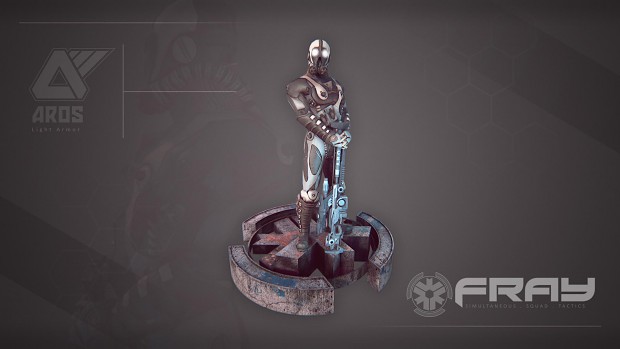
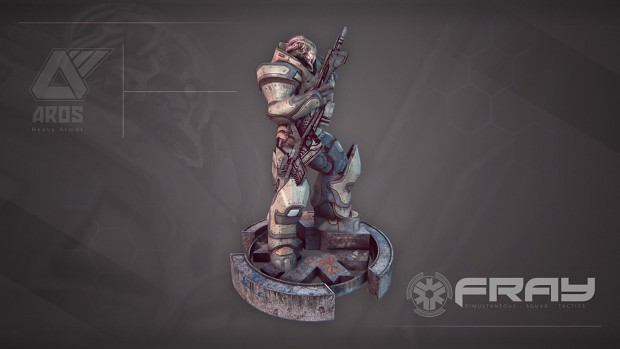
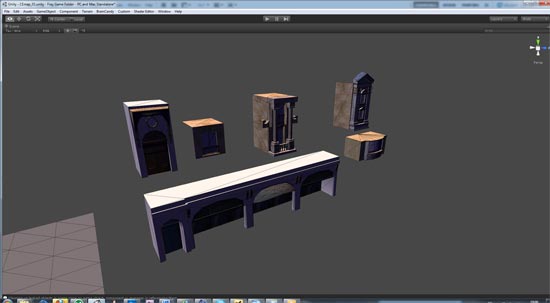
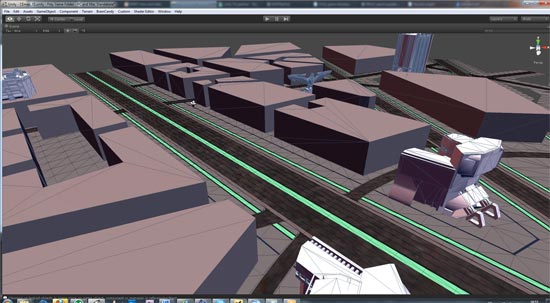
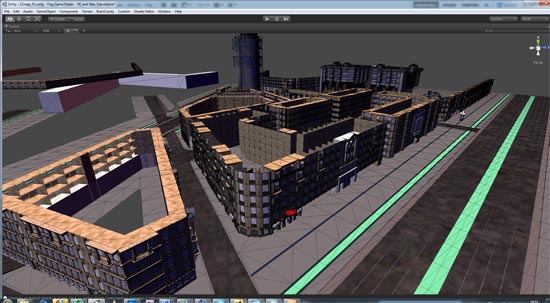










Wow this looks good can't believe I haven't seen this until now! Keep up the work! Looks sexy!
WOW. This is what news posts should be! Informative, new information, mixture of both text and pictures, very well thought out layout and good flow. I congratulate you!
Not to mention the game itself looks gorgeous and should be interesting. Are you planning it as a standalone game or will you also deploy through web?
Meant to vote up whoops.
Thanks guys, we are really pouring our souls into this project, trying to create something fun and original.
Fray will be a standalone game for PC and Mac. You'll probably be able to get it from Desura, Gamersgate, our website and maybe Steam.
awweesomemeeee
Giggity.